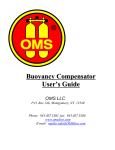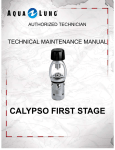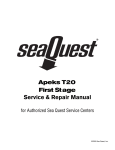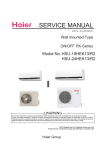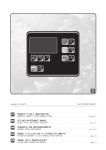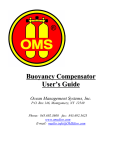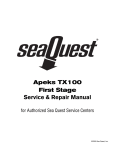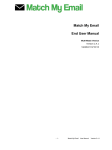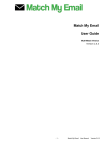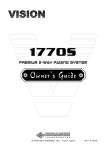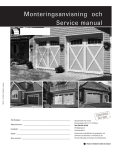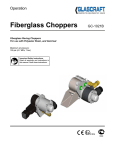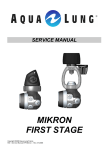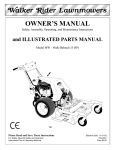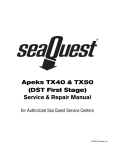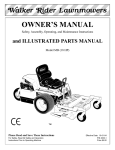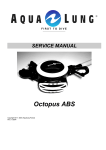Download Microsoft Word Viewer - R 600 first stage Service
Transcript
Contents COPYRIGHT NOTICE ....................................................................................................................................... 3 INTRODUCTION .............................................................................................................................................. 3 WARNINGS, CAUTIONS, & NOTES .................................................................................................................. 3 SCHEDULED SERVICE .................................................................................................................................... 3 GENERAL GUIDELINES .................................................................................................................................. 3 GENERAL CONVENTIONS .............................................................................................................................. 4 DISASSEMBLY PROCEDURES ....................................................................................................................... 4 REASSEMBLY PROCEDURES ........................................................................................................................ 7 ADJUSTING THE FIRST STAGE ...................................................................................................................... 9 FINAL ASSEMBLY ........................................................................................................................................... 9 TABLE 1 - FIRST STAGE TROUBLESHOOTING GUIDE ..................................................................................10 TABLE 2 - RECOMMENDED TOOL LIST .........................................................................................................11 TABLE 3 - RECOMMENDED LUBRICANTS AND CLEANERS .........................................................................12 PROCEDURE A - CLEANING AND LUBRICATION ..........................................................................................13 TABLE 4 -TORQUE SPECIFICATIONS ............................................................................................................14 TABLE 5 -TEST BENCH SPECIFICATIONS .....................................................................................................14 EXPLODED PARTS DRAWING .......................................................................................................................15 COPYRIGHT NOTICE This manual is copyrighted, all rights reserved. It may not, in whole or in part, be copied, photocopied, reproduced, translated, or reduced to any electronic medium or machine readable form without prior consent in writing from OMS LLC. It may not be distributed through the internet or computer bulletin board systems without prior consent in writing from OMS LLC. copyright OMS LLC. OMS D 600 First Stage Service Manual INTRODUCTION This manual provides factory prescribed procedures for the correct service and repair of the OMS LLC D 600 first-stage regulator. It is not intended to be used as an instructional manual for untrained personnel. The procedures outlined within this manual are to be performed only by personnel who have received factory authorized training through an OMS LLC Service & Repair Seminar. If you do not completely understand all of the procedures outlined in this manual, contact Aqua Lung America to speak directly with a Technical Advisor before proceeding any further. WARNINGS, CAUTIONS, & NOTES A n Official Inspection consists of: 1. A pressurized immersion test of the entire unit to check for air leakage. 2. Checking for stable intermediate pressure that is within the acceptable range. Checking for opening effort that is within the acceptable range. Checking for smooth operation of the control knob and venturi switch. A visual inspection of the filter for debris or discoloration. A visual inspection of the exhaust valve to see that it is in good shape and that it's resting against a clean surface. A visual inspection of the mouthpiece looking for tears or holes. Pulling back hose protectors and checking that the hoses are secure in the hose crimps. 3. 4. 5. 6. 7. 8. If a regulator fails item #1, 2, 3 or 4 the entire regulator should be overhauled. If a regulator fails 4, 5, 6 or 7 it will be up to the technician's discretion whether or not a full overhaul is required. GENERAL GUIDELINES 1. Pay special attention to information provided in warnings, cautions, and notes that are accompanied by one of these symbols: WARNINGS indicate a procedure or situation that may result in serious injury or death if instructions are not followed correctly. CAUTIONS indicate any situation or technique that will result in potential damage to the product, or render the product unsafe if instructions are not followed correctly. 2. 3. NOTES are used to emphasize important points, tips, and reminders. SCHEDULED SERVICE If the regulator is subjected to less than 50 dives per year, it is permissible to overhaul it every other year with an inspection procedure being performed on the "off" years. For example: Year #1: Inspection; Year #2: Overhaul; Year #3: Inspection Year #4: Overhaul, and so on. Both Inspections and Overhauls need to be documented in the Annual Service & Inspection Record in the back of the Owner's Manual to keep the Limited Lifetime Warranty in effect. If a regulator is subjected to more than 50 dives per year, it should receive the complete overhaul. 4. 5. In order to correctly perform the procedures outlined in this manual, it is important to follow each step exactly in the order given. Read over the entire manual to become familiar with all procedures before attempting to disassemble the first-stage, and to learn which specialty tools and replacement parts will be required. Keep the manual open beside you for reference while performing each procedure. Do not rely on memory. All service and repairs should be carried out in a work area specifically set up and equipped for the task. Adequate lighting, cleanliness, and easy access to all required tools are essential for an efficient repair facility. The regulator body will need to be secured in a vise when removing certain threaded parts, including the yoke clamp connector (21) and diaphragm clamp (6). NEVER SECURE THE REGULATOR BODY DIRECTLY IN A VISE. Instead, install a vise mounting tool into the high pressure port, then secure the vise mounting tool in the vise. If you do not have a vise mounting tool, use an EXPIRED CO2 i cartridge attached to a high pressure adapter (%' female to /,s" male). Never screw a CO2 directly into a low pressure port in case the neck of the CO2 cartridge breaks off, leaving the threads stuck in the regulator. As the regulator is disassembled, reusable components should be segregated and not allowed to intermix with non-reusable parts or parts from other units. Delicate parts, including inlet fittings and crowns which contain critical sealing surfaces, must be protected and isolated from other parts to prevent damage during the cleaning procedure. Use only genuine OMS LLC. parts provided in the first-stage overhaul parts kit (Item # ). DO NOT attempt to substitute another manufacturer's, part regardless of any similarity in shape or size. 5. 6. Do not attempt to reuse mandatory replacement parts under any circumstances, regardless of the amount of use the product has received since it was manufactured or last serviced. When reassembling, it is important to follow every torque specification prescribed in this manual, using a calibrated torque wrench. Most parts are made of either marine brass or plastic, and can be permanently damaged by undue stress. GENERAL TERMINOLOGY The following terminology and techniques are assumed unless otherwise stated: 1. When instructed to remove, unscrew, or loosen a threaded part, turn the part counterclockwise. 2. When instructed to install, screw in, or tighten a threaded part, turn the part clockwise. 3. When instructed to remove an o-ring, use the pinch method (see figure) If possible, or use a brass or plastic o-ring removal tool. Avoid using hardened steel picks, as they may damage the o-ring sealing surface. All o-rings that are removed are discarded and replaced with brand new o-rings. Pinch Method 1. Remove the hoses from the first stage using the appropriate sized wrenches. Install spare HP and LP port plugs into the empty ports, except for one LP port and one HP port. 2. Install the vice mounting tool into one of the HP ports and secure in a bench vise with the Diaphragm Retaining Cap (6) facing upward. Using a two-faced spanner wrench, unscrew the Antifreeze Retaining Cap (6) while holding the Intermediate Ring Spanner Tool (5) stationary. 3. With your finger, remove the Antifreeze Membrane (21) from the Antifreeze Retaining Cap. Turn the First Stage over so the piston (20) falls out into your hand. Press upwards on sides of O-ring to create protrusion. Grab o-ring or insert o-ring tool at protrusion to remove 4. 5. The following acronyms are used throughout the manual: LP is low pressure; HP is High pressure; IP is Intermediate pressure. Numbers in parentheses reference the key numbers on the exploded parts schematics. For example, in the statement, "...remove the o-ring (17) from the...” the number 17 is the key number to the HP plug o-ring. DISASSEMBLY PROCEDURES Note: Before performing any disassembly, refer to the exploded parts drawing, which references all mandatory replacement parts. Used parts must be replaced with new part Old parts, must not be reused under any circumstances - regardless of the age of the regulator or how much use it has received since it was last serviced. CAUTION: Use only a plastic or brass o-ring removal tool when removing o rings to prevent damage to the sealing surface. Even a small scratch across an o-ring sealing surface can result in leakage. Once an o-ring sealing surface has been damaged, the part must be replaced with a new one. Only plastic dental picks, may be used. 4. Using a 6mm hex wrench, unscrew and remove the Spring Adjustment Screw (12). Lift out the main spring (2). 8VLQJDIDFHVSDQQHUZUHQFKXQVFUHZWKH,QWHUPHGLDWH5LQJ IURPWKHERG\/LIWRXWWKH6SULQJ3ODWH 8VLQJDPPKH[ZUHQFKXQVFUHZDQGUHPRYHWKH6FUHZ +DQGZKHHO',1)LWWLQJ6OLGHRIIWKH+DQGZKHHO 7RUHPRYHWKHGLDSKUDJPLQVHUWDORZSUHVVXUHDLUQR]]OHLQWR WKHRSHQ/3SRUW:KLOHKROGLQJ\RXUWKXPERYHUWKHGLDSKUDJP LQMHFWDVPDOOEODVWRIDLULQWRWKH/3SRUWWRSRSRXWWKHGLDSKUDJP 5HPRYHWKH&RQLFDO)LOWHU(OHPHQW8VHD´RSHQ HQGRUDGMXVWDEOHZUHQFKWRUHPRYHWKH5HWDLQHU /LIWRXWWKH*XLGH3ODWHDQG3LVWRQ*XLGH +DQGZKHHO 8VLQJDPPKH[ZUHQFKXQVFUHZWKH%DODQFLQJ&KDPEHU 5HPRYHWKH25LQJIURPWKH5HWDLQHU+DQGZKHHO 6HSDUDWHWKH3LVWRQDQGDOODVVRFLDWHGSDUWVIURPWKH %DODQFLQJ&KDPEHU 8VLQJDPPKH[ZUHQFKUHPRYHDOOSRUWSOXJV DQGWKHLU25LQJV 5HPRYHWKH25LQJVIURPWKH%DODQFLQJ&KDPEHUWKHQ UHPRYHWKHZKLWH%DFN3UHVVXUH5LQJIURPLQVLGHWKH %DODQFLQJ&KDPEHU This Ends Disassembly Before starting reassembly, perform parts Cleaning and lubrication according to the Procedures outlined in Procedure A, titled Cleaning &Lubrication, on page 13. REASSEMBLY PROCEDURES 1. Assembly of the Balancing Chamber side of the regulator. Install a new, lubricated O-Ring (31) on the Balancing Chamber, followed by the white Back Pressure Ring (23). Follow with another lubricated O-Ring (26). 2. Following the diagram, assemble the Balancing Chamber in sequential order: 1) Cap (13), 2) Spring (3), 3) Guide Ring (14), 4) Piston (17) 3. With a 6mm hex wrench, install the Balancing Chamber assembly into the Body (8). Install the Body into the vice mounting tool, secure to the bench vise, and then proceed to tighten the Balancing Chamber assembly into the body. 4. Assembly of the Intermediate Pressure side of the regulator. Insert Rod Guide (1) into the Piston Guide (16). Place Guide Plate (24) on top of the Piston Guide. 5. Turn the regulator to the side so the low pressure side is facing sideways. Drop the Guide Plate (24) into the center hold of the stage body. Press on the Guide Plate support several times. Assembly should have spring tension. 6. Press a new diaphragm (22) into the first stage body. Insert Friction Ring (18). Make sure both Diaphragm and Friction Ring edges are set into the groove of the body. Run your finger around the edge of the diaphragm to make sure it is properly seated. 7. Place the Spring Plate (19) flat side down in the center of the diaphragm. Screw a vice mounting tool into the open HP port, securing it in a vice with the Intermediate Ring (5) facing upward. Use the face spanner wrench to tighten the Intermediate Ring until it stops. 8. Insert the Main Spring (2) into the Intermediate Ring (5). Thread the Adjustment Screw (12) into the Intermediate Ring until the first two threads are still visible. 9. Installing the DIN Adaptor i. ii. iii. Install a new O-Ring (29) into the face of the Retainer Handwheel (15). Insert the Retainer into the body and tighten it to 12 foot-pounds. ADJUSTING THE FIRST STAGE WARNING! Use eye protection for the next step in case of high velocity particulates ejecting out of valve during cleaning. 1. Attach the first stage (with no port plugs installed) to a fully charged (2500-3000 psi) cylinder. Slowly open the cylinder valve to blow out any particulate. 2. Install new, lubricated o-rings (27)(28) on all port plugs (10)(11). Install the port plugs using a 4mm hex wrench, but leave one LP open for the next test. Insert the conical end of the filter (4) into the threaded end of the Retainer Handwheel (15). Slide on the Handwheel (25). Install a new, lubricated O-Ring (30) into the end of the Screw Handwheel (9). Use a 6mm hex wrench to tighten it to 12 foot-pounds. Note: The primary LP port is 3/8”. When adjusting the regulator, install either a 3/8” blanking plug (10) or a 3/8” hose with a properly adjusted second stage. Alternatively, you may use a 3/8” female to 3/8” male adaptor attached to the LP test gauge, as long as the test gauge has a built in pressure relief. 3. Attach an LP test gauge (0-400 psi) to a low pressure hose and thread the hose into an open LP port. If your test gauge does not have an overpressurization relief valve, you must attach a properly adjusted second stage to the first stage to act as the relief valve in case of an HP leak. Make sure port plugs are installed in any open ports. CAUTION: If the pressure gauge rapidly exceeds 160 psi, there is a HP leak. Quickly close the cylinder valve and purge the regulator. Refer to the troubleshooting table for the causes of HP leaks. iv. Install lubricated o-ring (32) in o-ring groove of handwheel screw (90). 4. Assuming there are no leaks, adjust the low pressure by turning the adjustment screw: turning in the adjustment screw increases LP, turning it out decreases LP. Turn the adjustment screw in 1/8” turn increments and cycle the relief valve several times after each adjustment. When the LP is 135 psi, cycle the gauge relief valve on and off 10-15 times. After cycling, watch the gauge needle. The first stage LP should “lock up” at 145 psi. Make any adjustments as necessary. Allow the first stage to stay pressurized for several minutes and check the LP again to make sure it remains “locked up” at 145 psi. If the LP creeps up more than 3 psi, then there is a leak. Refer to the troubleshooting table for possible causes 5. Close the cylinder valve and depressurize the regulator by opening the gauge relief valve or by pressing the second stage purge button. Close the gauge relief valve and repressurize the system. The LP should still read 145 psi. If the pressure reading is different than the original setting, repeat steps 3 and 4 until the LP is stable. FINAL ASSEMBLY 1. With the regulator still pressurized, insert the Pressure Piston (20) into the dry chamber. Insert the Antifreeze Membrane (21) into the Antifreeze Retaining Cap (6). 2. Thread the Antifreeze Retaining Cap (6) onto the dry chamber until hand tight. Using the face spanner wrench, tighten the end cap until snug. 3. Recheck the medium pressure to make sure it is still at 145 psi. 4. Close the cylinder valve and depressurize the regulator. Remove the test gauge and reinsert the port plug(s). This Ends Reassembly Table 1- Troubleshooting Guide SYMPTOM High pressure creep (also causes second-stage leaks) External air leakage -OrSecondary diaphragm distended or burst Restricted air flow or high inhalation resistance through entire system POSSIBLE CAUSE TREATMENT 1. Piston (17) is worn or damaged 1. Replace piston 2. Crown (21) damaged. 2. Replace crown/orifice 3. Crown 0-ring (19) damaged or worn. 3. Replace 0-ring 4. HP plug (11) internal wall damaged 4. Replace HP plug 5. HP o-ring (27) damaged or worn 5. Replace 0-ring 6. LP Plug 0-ring (28) damaged or worn 6. Replace 0-ring 1. Port plug o-rings (27,28) worn or damaged 1. Replace o-rings 2. Membrane (22) worn or damaged 2. Replace membrane 3. Membrane (22) worn or damaged 3. Replace membrane 4. Membrane (22) seating surface damaged 4. Replace body 5 Antifreeze Membrane (21) loose 5. Tighten spring retainer (12) 6. Connector 0-ring (29) worn or damaged 6. Replace o-ring (29) 7. HP Plug o-ring (27) worn or damaged 7. Replace o-ring 1. Cylinder valve not completely open 1. Open valve; check fill pressure 2. Cylinder valve needs service 2. Switch to different cylinder 3. Filter (4) is clogged 3. Replace filter Table 2 - Recommended Tools PART NO. DESCRIPTION APPLICATION I.P. test gauge Intermediate pressure testing O-ring tool, set O-ring removal and installation Pin Spanner Wrench Diaphragm clamp, end cap Seat extract/install tool Piston removal Vise mounting tool Mounting first-stage into vise 5/8" open-end wrench Hose removal Torque wrench, foot-pound Inlet fitting, HP plug 3/4" box wrench Connector (removal) 3/4" box wrench adapter Connector (installation w/torque wrench) 5mm hex wrench Port plugs 6mm hex key HP plug, DIN connector (removal) 6mm hex key adapter HP Plug, DIN connector (installation w/torque wrench) 1/8" wooden dowel Crown, Filter (removal) Table 3 - Recommended Lubricants & Cleaners Christo-Lubec MCG-111 or 129 All 0-rings seals Lubrication Technologies 310 Morton Street Jackson, OH 45640 (800) 477-8704 CAUTION: Silicone rubber requires no lubrication. DO NOT apply grease or spray to silicone rubber parts. Doing so may cause deterioration of the material Oakite #31 Acid bath for reusable stainless steel and brass parts. White distilled vinegar (100 gr.) Acid bath for reusable stainless steel and brass parts. CAUTION: DO NOT use strong acids for the cleaning of any parts. These acids, even when strongly diluted, can harm chrome plating, and may leave a residue that is harmful to 0-ring seals and other parts. DAWN blue dishwashing detergent (diluted with warm water) Degreaser for brass and stainless steel parts; general cleaning solution for plastic and rubber "Household" grade Procedure For Cleaning & Lubrication (All OMS® Regulators) The R 600 First Stage and Nitrox This first stage, when properly cleaned and assembled, is authorized for use with enriched air nitrox (EAN) that does not exceed 40% (EAN 40). This model is authorized for nitrox use because it has undergone adiabatic compression testing and the authorized service kit components and lubricants are compatible in elevated oxygen environments. During cleaning, a mild detergent must be used to remove hydrocarbons (compressor oils) from the inside passageways of the first stage. For the first stage to remain EAN40 compatible, only use filtered compressed gas (hydrocarbons < 0.1 mg/'m3). Ordinary compressed breathing air (Grade E) usually does not meet this criterion. Once ordinary breathing air is used, the first stage is no longer EAN40 compatible until it is cleaned and serviced again. Cleaning Brass and Stainless Steel Parts 1. 2. 3. Preclean in warm, soapy water* using a nylon bristle tooth brush. Thoroughly clean parts in an ultrasonic cleaner filled with soapy water. If there are stubborn deposits, household white distilled vinegar or OMS Corrostop® in an ultrasonic cleaner will work well. DO NOT place plastic, rubber, silicone or anodized aluminum parts in vinegar. Remove parts from the ultrasonic cleaner and rinse with fresh water. If tap water is extremely "hard," place the parts in a bath of distilled water to prevent any mineral residue. Agitate lightly, and allow to soak for 5-10 minutes. Remove and blow dry with oil free low pressure (25 psi) filtered air, and inspect closely to ensure proper cleaning and like-new condition. Cleaning Anodized Aluminum, Plastic & Rubber Parts Anodized aluminum parts and parts made of plastic or rubber, such as box bottoms, box tops, dust caps, etc., may be soaked and cleaned in a solution of warm water mixed with OMS Corrostop® or Dawn dish soap. Use only a soft nylon brush to scrub away any deposits. Rinse in fresh water and thoroughly blow dry, using low pressure filtered air. CAUTION: Do not place plastic and rubber parts in acid solutions. Doing may cause the parts to prematurely degrade and/or break. Cleaning Hoses If buildup of corrosion is severe, it is permissible to soak only the hose fittings in the ultrasonic cleaner as needed, using OMS Corrostop® and not allow any solution to enter the hose. Rinse in fresh water and allow to dry with the cleaned ends hanging down. Blow filtered air through them prior to installing onto the regulator. Lubrication and Dressing Wear powderless, latex gloves when handling and lubricating o-rings. Keeping internal parts free from skin oils and other contaminates is important when running enriched air nitrox through a first stage. All o-rings should be lubricated with Christo-Lube® MCG111 or 129. Dress the o-rings with a very light film of the O2 grease, and remove any visible excess by running the o-ring between thumb and forefinger. Avoid applying excessive amounts of O2 grease, as this will attract particulate matter that may cause damage to the o-ring. Table 4 - Torque Specifications PART NUMBER DESCRIPTION (KEY NUMBER) TORQUE R-239 Yoke Connector (20) 12 foot-lbs AP1471/S DIN Connector (34) 12 foot-lbs HP Plug (18) 12 foot-lbs AP5309 AP1413, AP1408 HP Port Plug (27), LP Port Plug (31) 16-18 inch-pounds Table 5 - Test Bench Specifications TEST CONDITION ACCEPTABLE RANGE Leak Test Inlet 2,500-3,000 (1100) psig No leaks allowed Low Pressure Inlet 2,500-3,000 (1100) psig 130 to 145 psi Low Pressure Creep Inlet 2,500-3,000 (1100) psig 5 psi max between 5 to 15 seconds after cycling (purging) regulator (Not Responsible for Typographical Errors) OMS LLC P.O. Box 146, Montgomery, New York 12549 www.omsdive.com


















